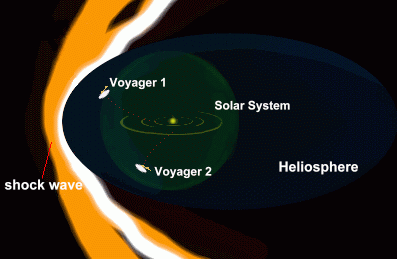 The two Voyager spacecraft, launched in the summer of 1977, are now heading out of our solar system and into interstellar space. They are the furthest man-made objects ever sent into space, and they are continuing to send back data as they pass into a region of space known as the 'heliosheath', a region where the solar wind gives way to interstellar gases.  Voyager 1 and 2 were designed as a two-spacecraft mission to study Jupiter and its large moon, Io, and Saturn and its large moon, Titan. The spacecraft were so successful in their missions to take high resolution pictures of the satellites, rings and moons of Jupiter and Saturn that Voyager 2 was then sent on an extended flight to Uranus and Neptune. By utilizing the gravity fields of Jupiter and Saturn to provide a gravitational boost to its speed, Voyager 2 was able to make it to Neptune a mere 12 years after leaving Earth. Meanwhile, Voyager 1 used the gravity of Saturn to send it travelling upward, out of the plane of orbit of the outer planets and toward the boundary of the solar system. Voyager 2 made a flyby of Uranus in early 1986, and passed closely by Neptune late in 1989. Much new information about Neptune was gathered, including data on cloud features, its magnetic field, mass, density, atmospheric composition, variations in temperature, wind speeds, and rate of rotation. These are still the only up-close images of Uranus and Neptune. As well, Voyager 2 took pictures of two of Neptune's moons, Triton and Nereid. Voyager's original four-year mission has now been extended to over 25, and is still continuing.The Voyager 1 spacecraft has now entered the solar system's edge, a vast region where the Sun's solar wind pushes against the thin gas that exists between stars. Voyager 1 is now 14 billion kilometres from the Sun, covering a distance of 536 million kilometres every year (more than three and a half times the distance of the Earth from the sun) at a speed of 61,000 km/hr. Voyager 1 is the farthest human-made object from Earth and the first spacecraft to reach interstellar space. Scientists think it will reach in the inner edge of the Oort Cloud in 300 years.  All of the planets and objects within our solar system are surrounded by a 'bubble' (called the heliosphere) created by the solar wind ... high-energy dust and particles emitted by the sun. The sun is moving through our galaxy and pulling the heliosphere along with it; a shock wave is formed where the solar wind is slowed by pressure from gas between the stars. At the boundary, the solar wind is slowed from speeds of up to 700 km per second and becomes denser and hotter. The Voyager 1 spacecraft is about to burst through the heliosphere and into the shock wave created by the solar wind. After that, it will be in interstellar space, if you don't count the Oort Cloud. Voyager 2 visited more planets than any other spacecraft, passing closely by Jupiter, Saturn, Uranus and Neptune. It was deflected downward by Neptune's gravitational field, and is heading below the plane of the planets. With a slower speed than Voyager 1, it is about eighty percent as far from the Sun. Knowing that both spacecraft would eventually leave the solar system and head into interstellar space, NASA placed a message aboard Voyager 1 and 2 ... a sort of time capsule that describes Earth and the people who live on it. The Voyager message is a 12-inch gold-plated copper disk containing sounds of nature, music, human voices in a variety of languages, and images 'selected to portray the diversity of life and culture on Earth'. The contents were selected by a committee chaired by Dr. Carl Sagan. Instructions, in symbols, explain the origin of the spacecraft and show how the disk is to be played. It will be forty thousand years before the spacecraft approach another planetary system. As Carl Sagan has noted, “The spacecraft will be encountered and the record played only if there are advanced spacefaring civilizations in interstellar space. But the launching of this bottle into the cosmic ocean says something very hopeful about life on this planet.” Find out where the Voyagers are in 2023 here. |